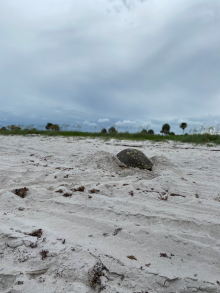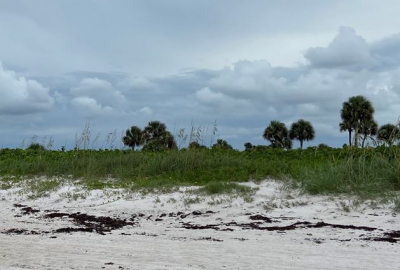Dune Plantings
Dune Protection
Dune vegetation plays an important role in stabilizing and keeping strong the Town's sand dunes on which they grow, which themselves form a defensive barrier for inland areas. With fast-growing, extraordinarily long roots, these plants thrive in low-nutrient and high-salt environments, and offer tremendous erosion control. The visible area of the plants captures wind blown sand, so the dunes slowly increase in size. Within the Town of Orchid, there are a variety of dune plants present, including grasses and vines.
Because of the important role dune plantings play in a healthy dune system, it's vital that these plants are not walked on or otherwise tampered with. In fact, the Florida Legislature has underscored the importance of coastal plant species in state statutes, which make it unlawful to damage or cause to be damaged sand dunes or their vegetation. And Florida Department of Environmental Protection's permitting policies aim to protect dune vegetation and endangered plant communities. Orchid also has implemented local law to protect these plants and no permit issued under the authority of the Town authorizes the disturbance or removal of dune vegetation. Beach access structures, including boardwalks and gazebos, must be elevated above dune vegetation and shall not preclude primary dune development or maintenance.
Sea Grapes and Sea Oats
Anyone endeavoring to trim or remove dune plantings must obtain a permit from the Florida Department of Environmental Protection before doing so. Sea oats and sea grapes are particularly protected. For instance, sea oat seeds may not be collected and removed from the beach without a specific permit allowing this activity. These plants may also not be cut back or removed. Sea grapes may only have a third of their height and/or leaf mass trimmed down annually and may not be reduced to less than six feet in height. Any pruning of a sea grape beyond these limits requires a permit from the Florida Department of Environmental Protection.
Sea Turtles

Pruning or removal of beachfront vegetation can have adverse impacts on protected sea turtles and their hatchlings. Vegetation often prevents lights from shining on the beach, which is important because sea turtles and hatchlings use light (that of the moon) to guide them back to the ocean. Light from an inland direction causes disorientation, which can result in injury or mortality of these creatures. Read more about sea turtles.

